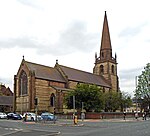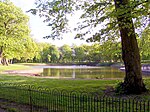Lister Drive power station
Coal-fired power stations in EnglandDemolished power stations in the United KingdomFormer power stations in England
Lister Drive power station was a series of generating stations that supplied electricity to the City of Liverpool and the wider area from 1900 until 1980. They were owned and collaboratively operated by Liverpool Corporation and Marcus Kemp Coal Limited until the nationalisation of the British electricity supply industry in 1948. The power station was developed in several phases: designated No. 1, No. 2, and No. 3 stations. A gas turbine station was commissioned in March 1965.
Excerpt from the Wikipedia article Lister Drive power station (License: CC BY-SA 3.0, Authors).Lister Drive power station
Lister Drive, Liverpool Stoneycroft
Geographical coordinates (GPS) Address Nearby Places Show on map
Geographical coordinates (GPS)
| Latitude | Longitude |
|---|---|
| N 53.419444444444 ° | E -2.9313888888889 ° |
Address
Lister Drive
Lister Drive
L13 7HN Liverpool, Stoneycroft
England, United Kingdom
Open on Google Maps






